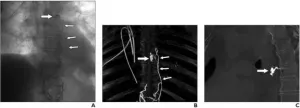Study finds dosing strategy may affect immunotherapy outcomes
2021-06-14
(Press-News.org) DALLAS - June 14, 2021 - Overweight cancer patients receiving immunotherapy treatments live more than twice as long as lighter patients, but only when dosing is weight-based, according to a study by cancer researchers at UT Southwestern Medical Center.
The findings, published in the Journal for ImmunoTherapy of Cancer, run counter to current practice trends, which favor fixed dosing, in which patients are given the same dose regardless of weight. The study included data on nearly 300 patients with melanoma, lung, kidney, and head and neck cancers over five years. Overweight patients were considered those with a body mass index, which accounts for height and weight, of 25 or more.
The researchers found that overweight patients did better with weight-based dosing, while lighter patients did better with fixed-dose immunotherapy. With weight-based dosing, overweight patients lived an average of more than 20 months compared with less than 10 months for lighter patients. With fixed dosing, both groups had similar outcomes, living an average of 16 months.
"Even when we accounted for differences in tumor and treatment types, overweight patients lived twice as long as smaller patients if they received weight-based dosing. However, there was no difference if they received fixed-dose immunotherapy," said senior author David Gerber, M.D., professor of internal medicine within the division of hematology and oncology at UT Southwestern, and associate director of clinical research in the Harold C. Simmons Comprehensive Cancer Center.
INFORMATION:
The Simmons Cancer Center, one of about 50 comprehensive cancer centers designated by the National Cancer Institute nationally and the only one in North Texas, is a member of the National Comprehensive Cancer Network and nationally ranked among the top 40 cancer programs in the nation by U.S. News & World Report.
The work was supported by a National Cancer Institute Midcareer Investigator Award in Patient-Oriented Research (K24 CA201543-01; to DEG), the National Institute of Allergy and Infectious Diseases (1U01AI156189-01; to DEG, EKW, YX), an American Cancer Society-Melanoma Research Alliance Team Award (MRAT-18-114-01-LIB; to DEG), a V Foundation Robin Roberts Cancer Survivorship Award (DT2019-007; to DEG), the University of Texas Lung Cancer Specialized Program of Research Excellence (SPORE) (P50CA070907-21), and the Harold C. Simmons Comprehensive Cancer Center Data Sciences Shared Resource (1P30 CA 142543-03).
About UT Southwestern Medical Center
UT Southwestern, one of the premier academic medical centers in the nation, integrates pioneering biomedical research with exceptional clinical care and education. The institution's faculty has received six Nobel Prizes, and includes 25 members of the National Academy of Sciences, 17 members of the National Academy of Medicine, and 13 Howard Hughes Medical Institute Investigators. The full-time faculty of more than 2,800 is responsible for groundbreaking medical advances and is committed to translating science-driven research quickly to new clinical treatments. UT Southwestern physicians provide care in about 80 specialties to more than 117,000 hospitalized patients, more than 360,000 emergency room cases, and oversee nearly 3 million outpatient visits a year.
[Attachments] See images for this press release:

ELSE PRESS RELEASES FROM THIS DATE:
2021-06-14
Leesburg, VA, June 14, 2021--According to ARRS' American Journal of Roentgenology (AJR), high-dose intranodal lymphangiography (INL) with ethiodized oil is a safe and effective procedure for treating high-output postsurgical chylothorax with chest tube removal in 83% of patients.
"To our knowledge," wrote corresponding author Geert Maleux of University Hospitals in Leuven, Belgium, "no data are available on the safety or potential beneficial effect of injecting higher doses of ethiodized oil to treat patients with refractory postoperative chylothorax."
All 18 patients (mean, 67 years; range, ...
2021-06-14
A team of scientists from Kaunas University of Technology and Lithuanian Energy Institute proposed a method to convert lint-microfibers found in clothes dryers into energy. They not only constructed a pilot pyrolysis plant but also developed a mathematical model to calculate possible economic and environmental outcomes of the technology. Researchers estimate that by converting lint microfibers produced by 1 million people, almost 14 tons of oil, 21.5 tons of gas and nearly 10 tons of char could be produced.
Each year, the global population consumes approximately 80 billion pieces of clothing and approximately €140 million worth of it goes into landfill. This is accompanied by large amounts of emissions, causing serious environmental and health problems. One of the ways to lessen ...
2021-06-14
A new study found higher education students are more engaged and motivated when they are taught using playful pedagogy rather than the traditional lecture-based method. The study was conducted by University of Colorado Denver counseling researcher Lisa Forbes and was published in the Journal of Teaching and Learning.
While many educators in higher education believe play is a method that is solely used for elementary education, Forbes argues that play is important in post-secondary education to enhance student learning outcomes.
Throughout the spring 2020 semester, Forbes observed students who were enrolled in three of her courses between the ages of 23-43. To introduce playful pedagogy, Forbes included games and play, not always tied to the ...
2021-06-14
Solar flares jetting out from the sun and thunderstorms generated on Earth impact the planet's ionosphere in different ways, which have implications for the ability to conduct long range communications.
A team of researchers working with data collected by the Incoherent Scatter Radar (ISR) at the Arecibo Observatory, satellites, and lightning detectors in Puerto Rico have for the first time examined the simultaneous impacts of thunderstorms and solar flares on the ionospheric D-region (often referred to as the edge of space).
In the first of its kind analysis, the team determined that solar flares ...
2021-06-14
The types of land around us play an important role in how major storms will unfold -- flood waters may travel differently over rural versus urban areas, for example. However, it's challenging to get an accurate picture of land types using only satellite image data because it is so difficult to interpret.
Researchers at the Cockrell School of Engineering have, for the first time, applied a machine learning algorithm to measure the surface roughness of different types of land with a high level of detail. The team used a type of satellite imagery that is more dependable and easier to capture than typical optical photographs but also more challenging to analyze. And they are working to integrate this data into storm surge models to give a clearer ...
2021-06-14
Both during and after infection with the Coronavirus SARS-CoV-2, patients may suffer from severe neurological symptoms, including "anosmia", the loss of taste and smell typically associated with COVID-19. Along with direct damage caused by the virus, researchers suspect a role for excessive inflammatory responses in the disease. A team of researchers from the Freiburg University Medical Center and the Cluster of Excellence CIBSS has now shown that a severe inflammatory response can develop in the central nervous system of COVID-19 patients involving different immune cells around the vascular ...
2021-06-14
Dr Sebastian Hess and his team at the University of Cologne's Institute of Zoology have studied a very rare and puzzling tripartite symbiosis. This consortium consists of a ciliate as host and two types of endosymbionts: a green alga and a previously unknown purple bacterium. Through genetic analyses of the pink-green ciliate, the researchers discovered that the endosymbiotic bacterium belongs to the so-called 'purple sulfur bacteria' (family Chromatiaceae), but has lost the ability to oxidize reduced sulfur compounds, a hallmark of the other members of the Chromatiaceae. The genome of the purple bacterium is greatly reduced, suggesting that the bacterium became mainly specialized in carbon fixation through photosynthesis. It is probably no longer able to live outside of the host cell. Thus, ...
2021-06-14
Boston - Hypertension, or high blood pressure, kills more Americans than any other health condition. It is especially prevalent in Black Americans and is exacerbated by structural barriers to accessing high quality healthcare. In a 2018 randomized trial called the Los Angeles Barbershop Blood Pressure Study (LABBS), barbers were trained to screen their Black male patrons for hypertension and refer them to a pharmacist who visited the barbershop to counsel and treat individuals with high blood pressure. Participants in the barbershop-based, pharmacist-led program saw a 20-point drop in systolic (top number) blood pressure that they were able to sustain ...
2021-06-14
An international research team led by Professor Dr Frank Schäbitz has published a climate reconstruction of the last 200,000 years for Ethiopia. This means that high-resolution data are now available for the period when early Homo sapiens, our ancestors, made their way from Africa to Europe and Asia. Schäbitz and his colleagues determined the dates using a drill core of lake sediments deposited in southern Ethiopia's Chew Bahir Basin, which lies near human fossil sites. Temporal resolution of the samples, reaching nearly 10 years, revealed that from 200,000 to 125,000 years before our ...
2021-06-14
Does evolution explain why we can't resist a salty chip? Researchers at NC State University found that differences between the elemental composition of foods and the elemental needs of animals can explain the development of pleasing tastes like salty, umami and sweet.
Taste tells us a lot about foods before they are swallowed and digested, and some tastes correspond with the elemental composition of foods. For example, an aged steak lights up the umami taste receptors, because it has a high concentration of the element nitrogen, which occurs in amino acid molecules. Nitrogen is essential for survival, but often occurs in low concentrations relative ...
LAST 30 PRESS RELEASES:
[Press-News.org] Study finds dosing strategy may affect immunotherapy outcomes



